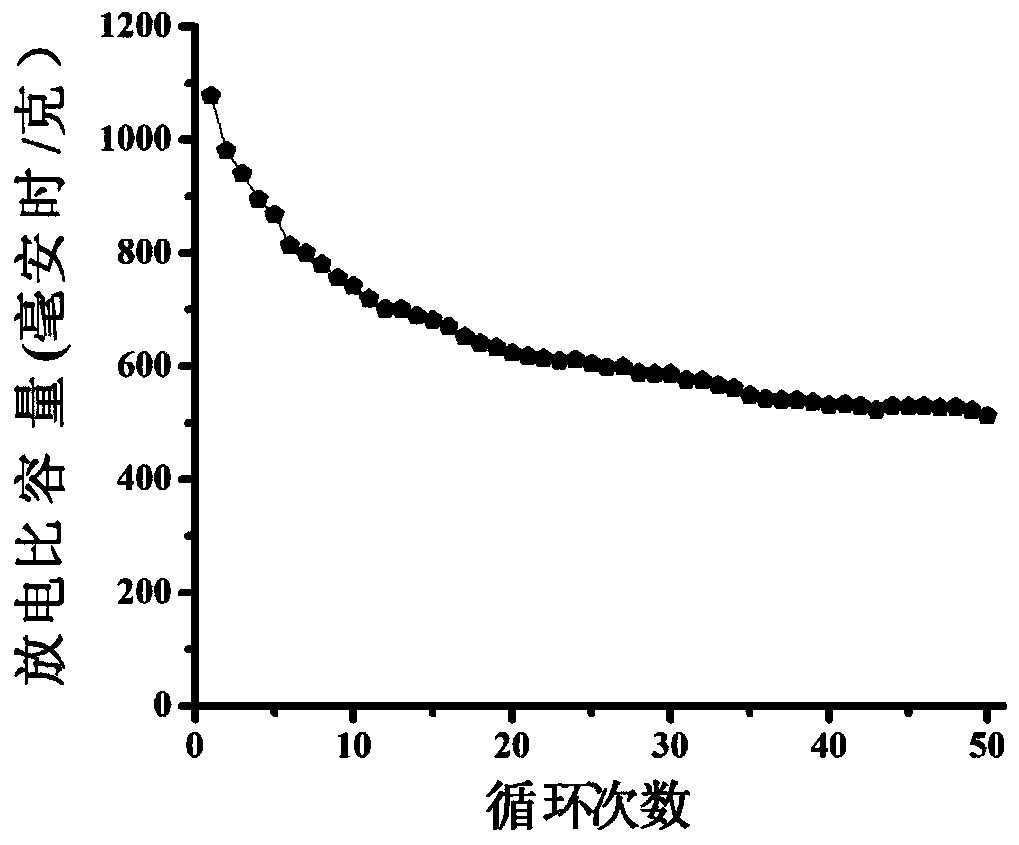Sodium-sulfur battery positive electrode material and preparation method thereof
A positive electrode material, sodium-sulfur battery technology, applied in the field of material chemistry, can solve the problems of low sulfur load, poor cycle stability, obvious shuttle effect, etc., achieve excellent conductivity, strong conductivity, and shorten the transmission path.
- Summary
- Abstract
- Description
- Claims
- Application Information
AI Technical Summary
Problems solved by technology
Method used
Image
Examples
Embodiment 1
[0025] (1) Preparation of metal organic framework material MIL-125:
[0026] First measure 30mL of N,N-dimethylformamide and 6mL of methanol, mix well, take 3g of phthalic acid and dissolve it in the mixed solvent, sonicate for 60 minutes, add 6mL of tetrabutyl titanate, sonicate for 60 minutes, then mix the above The solution was placed in a polytetrafluoroethylene-lined reactor and reacted at 140°C for 24h. After the reaction was completed, the product was cooled to room temperature with the furnace, and the product was collected by centrifugation, washed repeatedly with deionized water three times, and finally the washed product was placed in a vacuum drying oven at 60°C for 12 hours to obtain the metal-organic framework material MIL-125.
[0027] (2) Preparation of titanium dioxide-carbon composite materials:
[0028] Take 1.5 g of metal-organic framework material MIL-125 prepared in step (1), put it in 60 mL of graphene aqueous solution, the concentration of graphene aqu...
Embodiment 2
[0033] (1) Preparation of metal organic framework material MIL-125:
[0034] First measure 20mL of N,N-dimethylformamide and 5mL of methanol, mix well, take 2g of phthalic acid and dissolve in the mixed solvent, ultrasonicate for 30 minutes, add 5mL of tetrabutyl titanate, ultrasonicate for 30 minutes, and then The solution was placed in a polytetrafluoroethylene-lined reactor at 120°C for 24h. After the reaction was completed, the product was cooled to room temperature with the furnace, and the product was collected by centrifugation, washed repeatedly with deionized water three times, and finally the washed product was placed in a vacuum drying oven at 50°C for 12 hours to obtain the metal-organic framework material MIL-125.
[0035] (2) Preparation of titanium dioxide-carbon composite materials:
[0036] Take the metal-organic framework material MIL-1251g prepared in step (1), put it in 50 mL graphene aqueous solution, the concentration of graphene aqueous solution is 1 mg...
Embodiment 3
[0040] (1) Preparation of metal organic framework material MIL-125:
[0041] First measure 20mL of N,N-dimethylformamide and 5mL of methanol, mix well, take 2g of phthalic acid and dissolve it in the mixed solvent, sonicate for 30 minutes, add 5mL of tetrabutyl titanate, sonicate for 30 minutes, then mix the above The solution was placed in a polytetrafluoroethylene-lined reactor at 120°C for 24h. After the reaction was completed, the product was cooled to room temperature with the furnace, and the product was collected by centrifugation, washed repeatedly with deionized water three times, and finally the washed product was placed in a vacuum drying oven at 50°C for 12 hours to obtain the metal-organic framework material MIL-125.
[0042] (2) Preparation of titanium dioxide-carbon composite materials:
[0043] Take the metal-organic framework material MIL-1252g prepared in step (1), put it in 100 mL graphene aqueous solution, the concentration of graphene aqueous solution is ...
PUM
 Login to View More
Login to View More Abstract
Description
Claims
Application Information
 Login to View More
Login to View More - R&D
- Intellectual Property
- Life Sciences
- Materials
- Tech Scout
- Unparalleled Data Quality
- Higher Quality Content
- 60% Fewer Hallucinations
Browse by: Latest US Patents, China's latest patents, Technical Efficacy Thesaurus, Application Domain, Technology Topic, Popular Technical Reports.
© 2025 PatSnap. All rights reserved.Legal|Privacy policy|Modern Slavery Act Transparency Statement|Sitemap|About US| Contact US: help@patsnap.com

